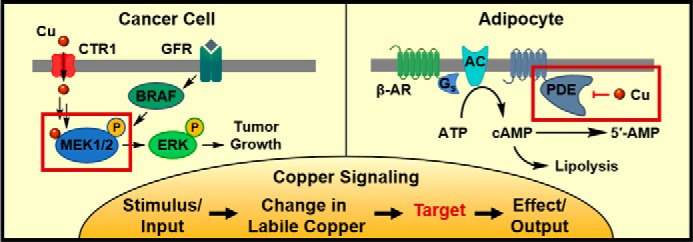Figure 2.

Copper-signaling pathways and molecular targets in mammalian biology. Left (Cancer Cell), stimulation of growth factor receptors (GFRs) or mutations in proto-oncogene protein B-Raf (BRAF) cause activation of the MAPK pathway, leading to phosphorylation of mitogen-activated protein kinase kinase (MAP2K1/2 or MEK1/2). MEK1/2 activation requires direct binding of cellular copper, which is supplied through the copper importer CTR1. Fully activated MEK1/2 phosphorylates MAPK or ERK, leading to tumor growth. Right (Adipocyte), activation of the β-adrenergic receptor (β-AR) causes recruitment of a G-protein (Gs) and activation of adenylyl cyclase (AC). Adenylyl cyclase converts adenosine triphosphate (ATP) to cyclic-adenosine monophosphate (cAMP), which activates downstream pathways leading to lipolysis. The pathway is shut down when cAMP is hydrolyzed by phosphodiesterase 3B (PDE). However, direct binding of copper to phosphodiesterase inhibits cAMP hydrolysis and maintains activation of the lipolysis pathway.
